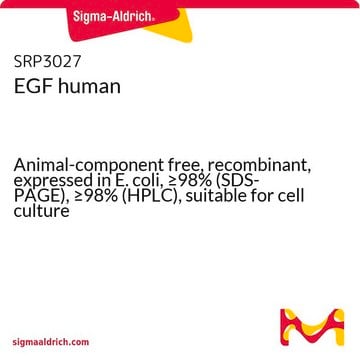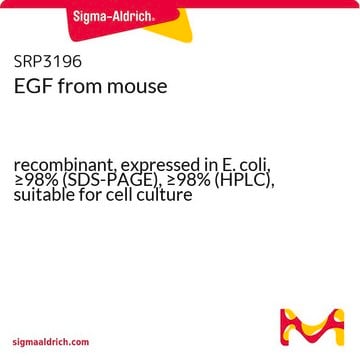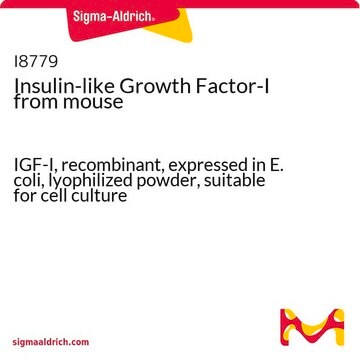E5160
Epidermal Growth Factor from mouse
≥90% (SDS-PAGE), recombinant, expressed in E. coli, lyophilized powder, suitable for cell cutlure
Synonym(s):
Mouse EGF, Mouse Epidermal Growth Factor
About This Item
Recommended Products
product name
Epidermal Growth Factor from mouse, EGF
biological source
mouse
Quality Level
recombinant
expressed in E. coli
Assay
≥90% (SDS-PAGE)
form
lyophilized powder
potency
0.05-1 ng/mL ED50/EC50
mol wt
~6 kDa
packaging
pkg of 100 μg
storage condition
avoid repeated freeze/thaw cycles
technique(s)
cell culture | mammalian: suitable
impurities
≤1 EU/μg endotoxin (Protein)
color
white
solubility
water: soluble 0.10 mL, clear, colorless
UniProt accession no.
storage temp.
−20°C
Gene Information
mouse ... Egf(13645)
General description
Application
Biochem/physiol Actions
Physical form
Citation
2. Jorissen, R.N., et al., Epidermal growth factor: mechanisms of activation and signaling. Exp. Cell Res., 284, 31-53 (2003).
3. Herbst, R.S., Review of epidermal growth factor receptor biology. Int.J. Radiat. Oncol. Biol., Phys., 59, S21-S26 (2004).
4. Mehta, V.B., and Besner, G.E., HB-EGF promotes angiogenesis in endothelial cells via PI3-kinase and MAPK signaling pathways. Growth Factors, 25, 253-263 (2007).
5. Bower, J.M., et al., The inhibition of gastric acid secretion by epidermal growth factor. Experientia, 31, 825-826 (1975).
6. Schonbrunn, A., et.al., Epidermal growth factor and thyrotropin-releasing hormone act similarly on a clonal pituitary cell strain. Modulation of hormone production and inhibition of cell proliferation. J. Cell Biol., 85, 786-797 (1980).
7. Mimura, Y., et al., Epidermal growth factor induces fibronectin expression in human dermal fibroblasts via protein kinase C delta signaling pathway. J. Invest. Dermatol., 122, 1390-1398 (2004).
8. Warner, M.R. et al., Ametantrone inhibits prostaglandin-mediated resorption in bone organ culture. Prostaglandins, 28, 469-476 (1984).
9. Grotendorst, G.R., et al., EGF and TGF-alpha are potent chemoattractants for endothelial cells and EGF-like peptides are present at sites of tissue regeneration. J. Cell. Physiol., 139, 617623 (1989).
10. Schultz, G., et al., EGF and TGF-alpha in wound healing and repair. J. Cell. Biochem., 45, 346-352 (1991).
11. George-Nascimento, C., et al., Characterization of recombinant human epidermal growth factor produced in yeast. Biochemistry, 27, 797-802 (1988).
Storage Class Code
11 - Combustible Solids
WGK
WGK 1
Certificates of Analysis (COA)
Search for Certificates of Analysis (COA) by entering the products Lot/Batch Number. Lot and Batch Numbers can be found on a product’s label following the words ‘Lot’ or ‘Batch’.
Already Own This Product?
Find documentation for the products that you have recently purchased in the Document Library.
Customers Also Viewed
Our team of scientists has experience in all areas of research including Life Science, Material Science, Chemical Synthesis, Chromatography, Analytical and many others.
Contact Technical Service









